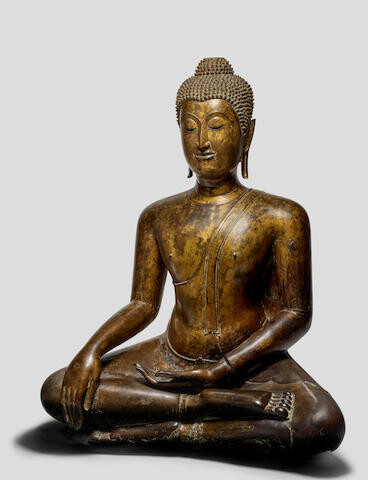A GILT COPPER ALLOY FIGURE OF BUDDHA
THAILAND, AYUTTHAYA PERIOD, 16TH CENTURY
THAILAND, AYUTTHAYA PERIOD, 16TH CENTURY
34 1/2 in. (87 cm) high
泰國 大城時期 十六世紀 銅鎏金佛陀像
This life-size bronze Buddha is a quintessential example of the Ayutthaya style at its creative peak. Buddha is here afforded an exquisitely proportioned dome and ushnisha, covered by symmetrical nubs of hair terminating in a heart-shaped hairline. The different planes of his face are subtly articulated, contrasting with the crisp lines delineating the eyes, nose, and mouth to achieve a serene yet confident expression. His waist and lower belly are also modelled with suppleness.
By the end of the 15th century, the Ayutthaya kingdom rose as the dominant political power in Thailand. Encompassing the lands of the former Mon, Khmer, and Sukhothai kingdoms, it is better understood as a patchwork of self-governing principalities rather than a unified state. Ethnic and political concerns are apparent in Buddha images produced for the Ayutthaya kingdom, a continuation of the syncretic art of the preceding U-Thong period (12th-15th century). U-Thong workshops experimented with the physiognomic representation and iconography of the Buddha, blending features associated with images produced by Mon, Khmer, and Thai artisans (Woodward, The Sacred Sculpture of Thailand, 1997, pp.145 & 177).
The present sculpture presents a refined synthesis of such ethnic features. For example, the figure's broad frame borrows from the Khmer tradition, yet is softened by the curvilinear forms of the Sukhothai tradition, seen for example in the gracefully elongated hands. Meanwhile, the eyebrows depart from both Khmer and Sukhothai modes, which would appear as either flat or as two arcs that do not meet in the middle, respectively. Instead, by joining before the bridge of the nose, the brows have more in common with the Mon-Dvaravati tradition. Unique to this sculpture is the way the facial modelling balances Sukhothai's oval shape, fleshy jowls, and prominent round chin with broader features and a squarer jaw, resulting in an enhanced compromise. Such blending of ethnic signifiers into the Ayutthaya style is suspected to have been intentional, promoting a sense of political unity among disparate principalities within the kingdom (ibid.).
A small, seated bronze Buddha, discovered inside the shoulder of a massive Buddha image known as the Phra Mongkhon Bophit and currently preserved at the Chantharakasem National Museum, Ayutthaya, is crucial for dating the present work (see McGill (ed.), The Kingdom of Siam, 2005, p.50, fig.35, no.33). Although much smaller in size, the Chantharakasem bronze closely resembles the current lot's body and facial type, and shares a similar treatment of robes and other stylistic details. As the Phra Mongkhon Bophit was constructed in 1538, the smaller bronzes found inside were mostly likely produced shortly beforehand, suggesting an early 16th-century date for the present bronze. Also compare a head of Buddha formerly in the Maitri Collection sold at Bonhams, New York, 20 Mar 2018, lot 3220.
Provenance:
Christie's, Amsterdam, 31 October 2000, lot 117
Private French Collection
View it on
Sale price
Estimate
Time, Location
Auction House
THAILAND, AYUTTHAYA PERIOD, 16TH CENTURY
THAILAND, AYUTTHAYA PERIOD, 16TH CENTURY
34 1/2 in. (87 cm) high
泰國 大城時期 十六世紀 銅鎏金佛陀像
This life-size bronze Buddha is a quintessential example of the Ayutthaya style at its creative peak. Buddha is here afforded an exquisitely proportioned dome and ushnisha, covered by symmetrical nubs of hair terminating in a heart-shaped hairline. The different planes of his face are subtly articulated, contrasting with the crisp lines delineating the eyes, nose, and mouth to achieve a serene yet confident expression. His waist and lower belly are also modelled with suppleness.
By the end of the 15th century, the Ayutthaya kingdom rose as the dominant political power in Thailand. Encompassing the lands of the former Mon, Khmer, and Sukhothai kingdoms, it is better understood as a patchwork of self-governing principalities rather than a unified state. Ethnic and political concerns are apparent in Buddha images produced for the Ayutthaya kingdom, a continuation of the syncretic art of the preceding U-Thong period (12th-15th century). U-Thong workshops experimented with the physiognomic representation and iconography of the Buddha, blending features associated with images produced by Mon, Khmer, and Thai artisans (Woodward, The Sacred Sculpture of Thailand, 1997, pp.145 & 177).
The present sculpture presents a refined synthesis of such ethnic features. For example, the figure's broad frame borrows from the Khmer tradition, yet is softened by the curvilinear forms of the Sukhothai tradition, seen for example in the gracefully elongated hands. Meanwhile, the eyebrows depart from both Khmer and Sukhothai modes, which would appear as either flat or as two arcs that do not meet in the middle, respectively. Instead, by joining before the bridge of the nose, the brows have more in common with the Mon-Dvaravati tradition. Unique to this sculpture is the way the facial modelling balances Sukhothai's oval shape, fleshy jowls, and prominent round chin with broader features and a squarer jaw, resulting in an enhanced compromise. Such blending of ethnic signifiers into the Ayutthaya style is suspected to have been intentional, promoting a sense of political unity among disparate principalities within the kingdom (ibid.).
A small, seated bronze Buddha, discovered inside the shoulder of a massive Buddha image known as the Phra Mongkhon Bophit and currently preserved at the Chantharakasem National Museum, Ayutthaya, is crucial for dating the present work (see McGill (ed.), The Kingdom of Siam, 2005, p.50, fig.35, no.33). Although much smaller in size, the Chantharakasem bronze closely resembles the current lot's body and facial type, and shares a similar treatment of robes and other stylistic details. As the Phra Mongkhon Bophit was constructed in 1538, the smaller bronzes found inside were mostly likely produced shortly beforehand, suggesting an early 16th-century date for the present bronze. Also compare a head of Buddha formerly in the Maitri Collection sold at Bonhams, New York, 20 Mar 2018, lot 3220.
Provenance:
Christie's, Amsterdam, 31 October 2000, lot 117
Private French Collection



